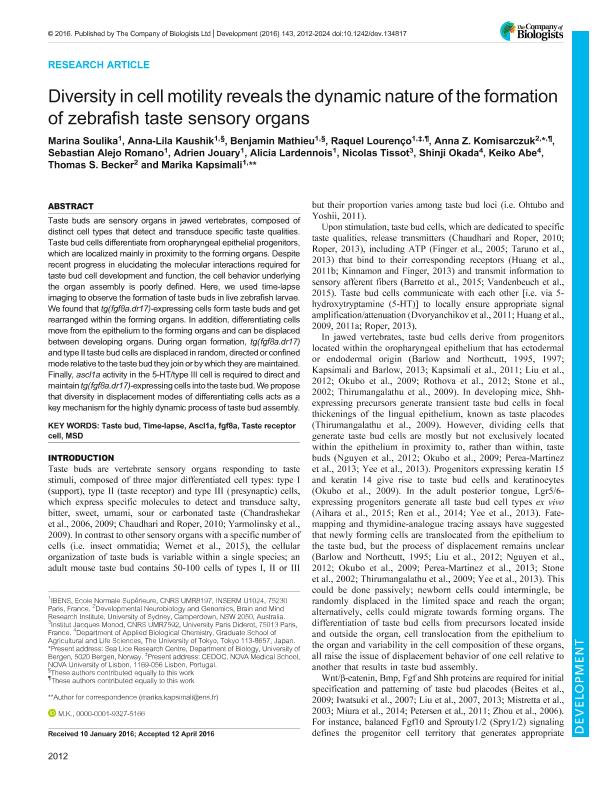Artículo
Diversity in cell motility reveals the dynamic nature of the formation of zebrafish taste sensory organs
Soulika, Marina; Kaushik, Anna-Lila; Mathieu, Benjamin; Lourenço, Raquel; Komisarczuk, Anna Z.; Romano, Sebastián Alejo ; Jouary, Adriene; Lardennois, Alicia; Tissot, Nicolas; Okada, Shinji; Abe, Keiko; Becker, Thomas S.; Kapsimali, Marika
; Jouary, Adriene; Lardennois, Alicia; Tissot, Nicolas; Okada, Shinji; Abe, Keiko; Becker, Thomas S.; Kapsimali, Marika
 ; Jouary, Adriene; Lardennois, Alicia; Tissot, Nicolas; Okada, Shinji; Abe, Keiko; Becker, Thomas S.; Kapsimali, Marika
; Jouary, Adriene; Lardennois, Alicia; Tissot, Nicolas; Okada, Shinji; Abe, Keiko; Becker, Thomas S.; Kapsimali, Marika
Fecha de publicación:
06/2016
Editorial:
Company of Biologists
Revista:
Development
ISSN:
0950-1991
Idioma:
Inglés
Tipo de recurso:
Artículo publicado
Clasificación temática:
Resumen
Taste buds are sensory organs in jawed vertebrates, composed of distinct cell types that detect and transduce specific taste qualities. Taste bud cells differentiate from oropharyngeal epithelial progenitors, which are localized mainly in proximity to the forming organs. Despite recent progress in elucidating the molecular interactions required for taste bud cell development and function, the cell behavior underlying the organ assembly is poorly defined. Here, we used time-lapse imaging to observe the formation of taste buds in live zebrafish larvae. We found that tg(fgf8a.dr17)-expressing cells form taste buds and get rearranged within the forming organs. In addition, differentiating cells move from the epithelium to the forming organs and can be displaced between developing organs. During organ formation, tg(fgf8a.dr17) and type II taste bud cells are displaced in random, directed or confined mode relative to the taste bud they join or by which they are maintained. Finally, ascl1a activity in the 5-HT/type III cell is required to direct and maintain tg(fgf8a.dr17)-expressing cells into the taste bud.We propose that diversity in displacement modes of differentiating cells acts as a key mechanism for the highly dynamic process of taste bud assembly.
Palabras clave:
Ascl1a
,
Fgf8a
,
Msd
,
Taste Bud
,
Taste Receptor Cell
,
Time-Lapse
Archivos asociados
Licencia
Identificadores
Colecciones
Articulos(IBIOBA - MPSP)
Articulos de INST. D/INV.EN BIOMED.DE BS AS-CONICET-INST. PARTNER SOCIEDAD MAX PLANCK
Articulos de INST. D/INV.EN BIOMED.DE BS AS-CONICET-INST. PARTNER SOCIEDAD MAX PLANCK
Citación
Soulika, Marina; Kaushik, Anna-Lila; Mathieu, Benjamin; Lourenço, Raquel; Komisarczuk, Anna Z.; et al.; Diversity in cell motility reveals the dynamic nature of the formation of zebrafish taste sensory organs; Company of Biologists; Development; 143; 11; 6-2016; 2012-2024
Compartir
Altmétricas



